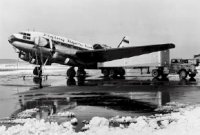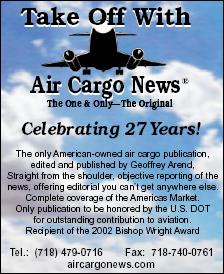|
You are currently
in the Archives section. Please be aware that some information and links
in the archived page may be outdated.
Click here
to return to the Archives' main page to see the list of archived articles.
|
A
R C H I V E S
RECREATING
HISTORY
In
1931, aviator Clyde Pangborn accompanied by Hugh Herndon Jr. as co-pilot,
took off from Sabishiro Beach near Misawa, Japan in a Bellanca Skyrocket
nicknamed ‘Miss Veedol,’ bound for Seattle, Washington.
Forty-one hours and thirteen minutes later,
the intrepid aviators landed at Wenatchee, Washington becoming the first
aviators in history to cross the Pacific Ocean by air.
The
story is especially noteworthy for air cargo because before the pilots departed
upon their journey, they presented the town folk in Misawa with saplings
from native Washington red delicious apples.
The Japanese in turn gave the fliers half
dozen Jonathon apples from a local farm to enjoy during their epoch flight.
Today, all over Japan, red delicious apple
descendants from those first saplings are still being consumed.
Even better in 1981, Misawa Japan and Wenatchee
Washington recalling their historic connection became sister cities.
Now
a group of pilots are rebuilding an exact replica of the ‘Miss Veedol’ with
more than $600,000 raised by people on both sides of the mighty Pacific
Ocean, in two small towns.
Next
year to celebrate the Centennial of Flight—100 years since Kitty Hawk, the
Pacific will once again be flown, as before by Clyde Pangborn, as Miss Veedol
again takes wing from Misawa arriving at Pangborn Memorial Airport in Washington
all the way from Japan. More info.: pangborn@bossig.com. |
|

They
Fly By Night . . . Once upon a time, in 1942 modern air cargo was
born above the rugged Himalayas, as the China India Burma Hump airlift
carried vital war supplies between Assam, India and Kunming, China.
The air bridge connected the “double
bubble” fuselage (an early method for aircraft pressurization) Curtiss
C-46 Commando with the Curtiss P-40’s of the American Volunteer
Group (AVG) better known as Flying Tigers.
Little did anyone imagine that one
of the Curtiss C-46 transport pilots, carrying fuel and supplies
over the Hump, named Robert Prescott, would return to the U.S. to
lead an all-cargo airline of war-surplus Commandos called Flying
Tigers.
Coming in January, here on aircargonews.com,
an exclusive preview chapter “Over The Hump” from the landmark book
“Air Cargo—An Illustrated History” to be published by Air Cargo
News next summer.
|
 |


